How to put a crown on a tooth
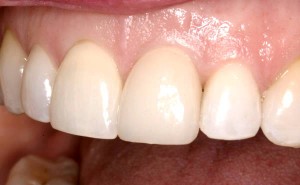
In people who have lost one or more teeth, especially in the smile zone, there is a need for their restoration.
This can be done with the help of crowns and bridges.
Sometimes it becomes necessary to install crowns even with all teeth.
The installation of the crown on the tooth is made at certain indications.
In which cases you need to install a crown
Installation of crowns is necessary in the following cases:
- The presence of an extensive carious process.
- Tooth decay due to trauma, but maintaining its root.
- The presence of defects or discoloration of the teeth, which gives them an unaesthetic appearance.
- Pathological abrasion of enamel. The presence of a crown helps protect the tooth from the influence of negative factors.
- When loosening teeth associated with periodontal disease, fixation of temporary crowns is possible, which makes the teeth more stable.
- When installing a bridge structure, when crowns can be fixed on healthy abutments.
How to put a crown on a tooth
The installation of the crown on the tooth is carried out in several stages.
The first stage is preparatory
At this stage, a treatment plan is drawn up and possible options for prosthetics are considered.
The dentist focuses on the installation of certain crowns, depending on the clinical case and the results of x-rays.
Having appreciated the pros and cons of the proposed prosthetics options by the doctor, the patient makes the final decision.
Subsequently, a treatment plan is drawn up, according to which further actions by the doctor will be carried out.
The following procedures may be included in the treatment plan:
- Removal of dead non-viable teeth.
- Preparation of teeth for the installation of crowns.
- Definition and coordination of the type of crowns.
- When installing the bridge, the number of supporting teeth necessary for its fixation is clarified.
- The cost of prosthetics with crowns is calculated taking into account the treatment.
- The timing of the manufacture and fixation of crowns is being specified.
Teeth preparation is the most important aspect of prosthetics.
- Before putting a crown on a tooth, it is treated and prepared (depulpation and turning).
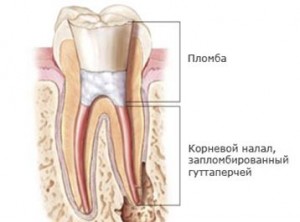
photo: Filling the canals and the crown of the tooth - In the process of preparation, teeth are treated, root canals are filled, tartar is removed.
- If a single-root tooth is prepared for prosthetics, then it is depulped (nerve removal) in order to prevent pulp burns during tooth turning.
- With prosthetics of chewing teeth, the risk of thermal burn during tooth turning is much lower than in root-teeth. Therefore, they are often left alive.
- If a live tooth is undergoing prosthetics, the turning is performed under local anesthesia, the effect of which lasts at least an hour.
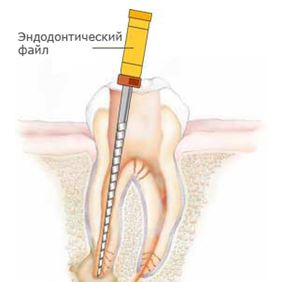
Photo: Root canal enlargement
When a tooth is pulped out:
- Nerve removal.
- Instrumental processing and expansion of root canals.
- Canal filling.
- Filling of the crown of the tooth.
With severe destruction of the crown of the tooth, before prosthetics, the nerve is removed and the root canals are sealed.
Then the dentist restores the crown of the tooth.
Ways to restore the crown
There are two ways to repair a severely damaged crown:
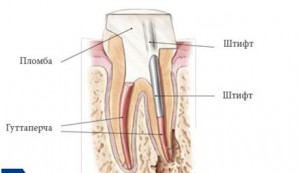
- With a pin.
A pin is screwed into the sealed root canal with subsequent restoration of the crown from the filling material on its basis.
Only after this is the tooth turned.
- Using the cult tab.
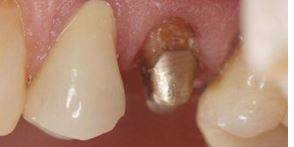
photo: Tooth restored by the stump tab
The tab is made in the dental laboratory and consists of two parts: root and crown.
The root part is fixed in the root canal of the tooth, and the crown part is already prepared for fixing the crown.
The restoration using the stump tab is considered more reliable and ensures a long crown life.
Tooth preparation
In the process of preparation, the tooth is turned.
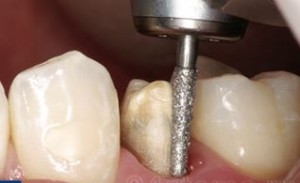
- With the help of diamond burs, the doctor gives the tooth a special shape.
- The preparation of live teeth is carried out under local anesthesia.
- When turning a dead tooth, anesthesia is also desirable, since during the preparation the gum is moved away from the tooth.
- The tissue grinding is performed on the thickness of the future crown.
When installing cast enamel crowns, less is removed than when fixing cermets or ceramics.
After turning, the stump remains, on which the crown will subsequently be fixed.
The second stage is laboratory
Casting is done by the dentist after the teeth are fully prepared for prosthetics.
- Using a special impression mass from machined teeth, casts are taken.
- Based on the casts, gypsum models of teeth are made in the laboratory.
- On gypsum models, crowns are made.
Crowns
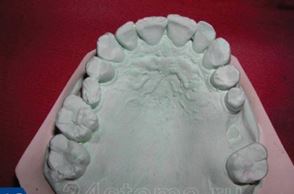
Crowns are made according to the obtained plaster models.
Designs can be made of metal, ceramic or cermets.
Due to the fact that the manufacture of crowns is a lengthy process, the patient is offered to temporarily fix plastic crowns.
This is necessary to restore aesthetics and protect the turned surface of the tooth from the aggressive environment of the oral cavity.
The third stage - fitting and fixing crowns
The fitting is necessary in order to assess the quality of the metal frame of the crown and to clarify the shade of the future design.
- If the crown sits perfectly, then the frame is covered with ceramic mass.
- After the crown is ready, the installation technology is such that the structure is fixed to the tooth using special cement. Initially, temporary cement is used for fixation to evaluate how the tooth behaves with respect to antagonist teeth. If you fix the crown on a permanent cement, then in case something goes wrong, you won’t be able to remove it, you will need to saw the structure.
- After a couple of weeks, if everything is normal, the crown is fixed to the tooth using permanent cement.
- After removing the crown from temporary cement, it is thoroughly cleaned.
- The stump is sandblasted to roughen its surface.
- Permanent dental cement is applied to the inside of the structure and the crown is put on the tooth.
- The design is irradiated with a special lamp that accelerates the hardening of cement.
- Careful removal of excess cement, as it gets on the gum can cause inflammation and irritation.
- After an hour and a half, a chewing load can be given to the structure.And after 24 hours, you can put the maximum load on the crown.
Locking crowns
The installation of crowns on the lock fasteners is one of the promising areas that allows you to minimize your teeth.
The use of lock crowns facilitates the process of fixing and removing structures.
Locks are attached to the abutment teeth with cement.
Fixation of crowns on implants
Such prosthetics do not require the preparation of teeth.
The design can be fixed in one of the ways:
- With screws. The crown connects to the abutment, which is an adapter between it and the implant. The design is screwed to the implant, which passes through the hole in the crown. Then the canal is closed with special filling cement.
- With cement fixation. A dental crown is placed on the abutment using dental cement.
Video: “Dental crowns in dentistry”
In what cases are crowns removed?
Unfortunately, crowns are sometimes required.
This may be due to:
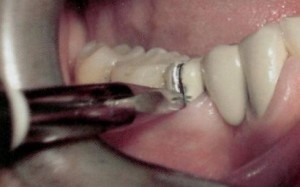
- With poor-quality tooth preparation for the installation of the prosthesis. According to statistics, 60% of cases are poorly performed root canal filling. Subsequently, this leads to the formation of an inflammatory process and the need to remove the crown and tooth treatment. Therefore, when choosing a dentist, you need to make sure of his high qualifications.
- With the presence of errors in the manufacture of the structure. If the design distorts the bite, does not tightly cover the neck of the tooth, creates problems of aesthetic or physiological nature, then this design must be removed.
- With planned replacement of crowns. Any crown has a certain service life, so after some time the crown will need to be replaced.
- An urgent replacement of the crown may be required if the structure is damaged, a crack or holes appear on the site of the washed cement.
- In case of complications.
After fixing dental crowns, complications can sometimes occur:
- Excessive pressure of the structure on the soft tissue of the gums can lead to circulatory disorders, the formation of pressure sores and the death of the mucous tissue at the border of the contact of the crown with the gum. As a result, prosthetic stomatitis develops.
- The development of caries of supporting teeth. It can occur as a result of poor-quality preparation of teeth for prosthetics, or with poor oral hygiene, when under the crown there is an accumulation of food residues, which are a breeding ground for the development of microorganisms that cause caries.
- The presence of allergies to materials that were used in the manufacture of the prosthesis. Symptoms of an allergic reaction can occur immediately after fixation of the structure or after some time. Intolerance is manifested by a burning sensation, dryness, rashes in the oral cavity.
- Galvanic syndrome. It occurs if dentures made of different metals are present in the oral cavity. As a result, an electric current is generated that enhances oxidative reactions. Symptoms are manifested as: the presence of a metallic taste in the mouth, headache, malaise, discoloration of the structure and adjacent teeth.
The presence of any of the complications requires immediate medical attention.
Untimely seeking help is fraught with the loss of an abutment.
Usually, crowns are removed and a prosthesis is performed after all complications have been removed.
How to remove dental structures
The process of removing dental crowns is a rather complicated procedure, especially if you want to keep the structure in its original form in order to re-fix it in its original place.
If it is necessary to remove the crown due to breakage, it is cut using special dental instruments.
If you still need to save the prosthesis, then use:

- Crown pickups (for example, Kopp's hook) are tools that are automatic or manual flat hooks that allow you to remove the prosthesis after fixing it at the border of the connection between the tooth and the crown.
- Nippers allow reliable grip of the structure with jaws and remove it from the base.
- Ultrasonic installations. With the passage of ultrasound at the junction of the structure with the stump of the tooth, the destruction of cement occurs, and the crown is easily removed.
- The use of pneumatic tools, under the influence of which the destruction of the cement substance occurs and the removal of the structure is facilitated.
Cost
It is not easy to answer exactly the question: “How much does the installation of a crown cost?”, Since the design price depends on the material, the method of manufacturing the crown, the status of the clinic, and the professionalism of the dentist.
When calculating the final cost of structures, the amount of treatment performed at the stage of preparation for prosthetics is taken into account.
| Type of crown | Price, rub.) |
| Metal | 3000 to 16000 |
| Ceramic | From 20,000 |
| Cermet | 6,000 to 40,000 |